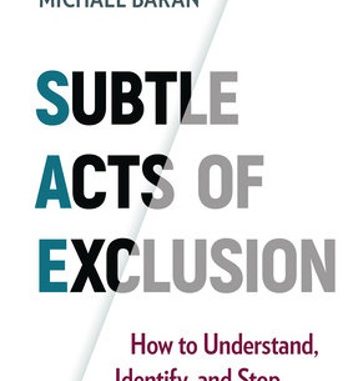
Subtle Acts of Exclusion: How to Understand, Identify, and Stop Microaggressions by authors Tiffany Jana and Michael Baran is a brief but deep look into how individuals offend or harm others without intending to with their choice of words. Jana and Baran are longtime researchers in this area and their credentials are as varied as their personal backgrounds. Baran is a Senior Partner and Digital Solutions Lead at inQUEST Consulting, working to support organizations in their diversity, equity, and inclusion efforts. Jana has experienced life at every level, holds an assortment of degrees, and CEO of TMI Portfolio, a collection of companies striving to advance inclusive workplaces. This is her third book following earlier publications Overcoming Bias and the second edition of the B Corp Handbook. With this book, they are offering our society an unfettered look at how our poor choice of words, no matter the intent behind them, can wreak harm on people in ways we never expect.
It is an intensely human account. Jana, in particular, is unafraid to relate her own experiences with subtle acts of exclusion, or SAE as the authors dub it throughout the course of the book, and likewise admits her own culpability with such behaviors. Both authors are forthright from the first that they are not exempt from such failures and this adds dimension to the text we seldom find in non-fiction material with roots in social science. Baran is no exception. The personal touch rife throughout Subtle Acts of Exclusion: How to Understand, Identify, and Stop Microaggressions pairs well with the experiences they document others contend with sometimes daily. Many authors maintain a certain amount of distance from the reader, but it isn’t the case with this book.
PURCHASE LINK: www.amazon.com/Subtle-Acts-Exclusion-Understand-Microaggressions/dp/1523087056
They give readers an important grounding in the idea of microaggression/SAE, counter arguments numerous pundits and authors make against its validity, and offer an informal guide to how everyone can work together against such behaviors and make them known when they occur. Chapter Five through Ten are thoughtful looks at the various areas where SAE are prevalent in our world and offer numerous examples drawn from individual lives attesting to how such behavior can affect another’s psychological well-being.
It isn’t about personal stories alone. Baran and Jana harness the full breadth of their academic talents to support the book’s ideas with well-chosen research without overwhelming readers with a wealth of secondary material. The book’s prose, likewise, has a brisk pace capable of keeping readers engaged without ever glossing over any topic. The language is conversational and never fraught with an abundance of academic terminology that might lose the regular reader. This is critical to the book’s success. Jana and Baran aim their book at the workplace environment, in some respects, but the lessons they share with readers possess universal application. Subtle Acts of Exclusion: How to Understand, Identify, and Stop Microaggressions will likely enjoy widespread appeal and remain a key text regarding this topic for some time to come. It takes an intellectual and heartfelt look at each issue.
Clay Burton
